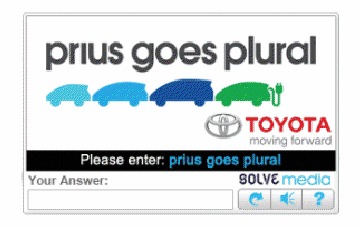Captchas are an easy way to prevent automated bots from diminishing the quality of a website, which is why you’ve probably spent a good amount of time squinting at their bent, fuzzy text. Current computer programs have a hard time reading them, and it turns out that so do humans. On average it takes us about 12 seconds to solve one. They’re one of the only online spaces where consumers involuntarily apply any focus.

In other words, Captchas are excellent advertising real estate.
“People are not paying attention to banner ads,” says Solve Media CEO Ari Jacoby, who cofounded the company in September 2010. “When they’re sending email they’re focused on email, when they’re playing games they’re focused on that, and when they’re reading an important news story they don’t even see the ad.”
Solve Media replaces Captchas with ads that require consumer participation. A recent Toyota campaign, for instance, required consumers to type in “Prius goes plural” to prove they were humans and not bots. The ads are easier to read than Captchas, and this theoretically saves consumers time. Meanwhile, Solve Media serves likely bots tougher problems so security isn’t compromised by the easier puzzles it serves to consumers.
More than 2,000 publishers, including AOL, the Tribune Company and Meredith Corporation, have partnered with Solve Media. Revenue share differs from site to site, but Jacoby says Solve Media and publishers typically split it.
The company has also recruited more than 75 advertisers including Toyota and IHG (which owns Holiday Inn). Just as Google sells advertising based on how many people click on promoted search results, Solve Media also sells ads based on how many consumers actually type in a brand message. So far, that’s happened about 18 million times.
Consumers are forced to engage with a brand in order to participate in web activities. It’s like television advertising before Tivo.
“[Banner] ads are adjacent to the content we’re reading as opposed to network television, where the ads are literally sandwiched between content segments,” Jacoby says. “We took a page from [television’s] playbook.”
Source: mashable
 Follow
Follow